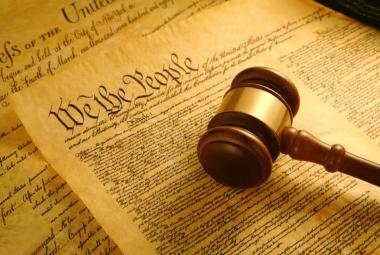The Constitution provides the framework for one of the oldest republics in history. This document has been under attack since its adoption, but no more so than over the last half-century.
Next month, the United States is preparing to undergo a revolution—a peaceful revolution that occurs every four years. It is a national election that decides the new chief executive, as well as the makeup of the entire House of Representatives (lower house) and one-third of the Senate (upper house). It is a process that was crafted over 200 years ago by a group of men called the Founding Fathers. This process was embodied in a document called the United States Constitution. It provides the framework for one of the oldest republics in history. This document has been under attack since its adoption, but no more so than over the last half-century.
America’s Declaration of Independence, like the Constitution, was as Thomas Jefferson said, “the product of the American mind.” It was crafted with the same purpose as the Constitution—to establish a government where the people were sovereign and whose purpose was not to rule by majority as in a democracy, but to protect an individual’s rights, which were “endowed by their Creator.”
The specified rights were few, but vital. The Declaration of Independence stated that those rights were the rights to life, liberty, and the pursuit of happiness.
The United States Constitution and its first ten amendments, called the Bill of Rights, codified what was required to preserve those rights. They spelled out the freedom of speech and assembly; the freedom of the press; the right to bear arms; protection against unreasonable search and seizure; the right to a fair trial; and, the right for the states to decide how they wish to govern themselves in those areas not expressly given to the federal government.
There have been assaults on these rights of late. Franklin Roosevelt called for a “Second Bill of Rights”: the right to a living wage, the freedom from unfair competition and monopolies, and the rights to housing, medical care, education, and social security.
The United Nations has produced a thirty-one article titled, “Universal Declaration of Human Rights.” While it incorporates most of the tenets of the founding documents of the United States and FDR’s Second Bill of Rights, it also includes: protection against unemployment, the right to a holiday (with pay) from work, and the right to an education, which is defined as “the full development of the human personality and to the strengthening of respect for human rights and fundamental freedoms.”
While many of the “rights” touted by Roosevelt and the United Nations are desirable, one has to be cautious to call them rights. A right is something that must be protected by the government, even at the expense of another citizen’s life or liberty.
The Founding Fathers were very careful of the rights they listed in the Constitution. They believed that the rights set forth in the Constitution were offshoots of those God-given rights that were enumerated in the Declaration of Independence. In fact, there was much debate about even passing the Bill of Rights. Opponents of the Bill of Rights believed that if they enumerated those rights, later generations would infer that those are the only rights that were sacrosanct. Opponents believed that the individual states should decide these issues. Proponents of the Bill of Rights were deeply distrustful of a central government and knew that a person’s rights may be violated by an over-reaching federal government, thus the need to specify those rights in the Constitution itself. Those in favor of the Bill of Rights were so vehement in their belief in a Bill of Rights that they refused to ratify the Constitution without it.
When the delegates to the Constitutional Convention met in May 1787, presumably to “revise” the Articles of Confederation, Virginia delegate George Mason wrote, “The Eyes of the United States are turned upon this Assembly and their Expectations raised to a very anxious Degree.”1 (Mason had earlier written the Virginia Declaration of Rights, a document that Thomas Jefferson drew on when he wrote the first part of the Declaration of Independence.) Mason was disillusioned with the newly drafted Constitution and became one of the Constitution’s most vocal opponents. “It has no declaration of rights,” Mason complained. George Mason’s view was shared by many of the other delegates.
In an agreement that probably could not happen in today’s partisan times, a verbal agreement was reached in the convention that if the states ratified the Constitution, the first order of business for the new national legislature would be to craft a Bill of Rights for ratification by the states. When James Madison drafted the amendments, he drew heavily upon the ideas put forth in Mason’s Virginia Declaration of Rights.
A Recognition of Fallen Man
The Constitution was drafted knowing that Man was a fallen creature and the tenants of Constitution plays upon that weakness. As opposed to the Articles of Confederation, the colonies’ first governing document, the positions created by the Constitution: President, Vice President, Senator, and Representative were intentionally created to be powerful. The idea was to attract ambitious men who craved power. (The position of Supreme Court Justice was not designed to be an elected position since the framers believed that judges needed to possess “unique qualifications” and needed to be selected by members of the Senate who would be in a better position to know men who would possess these qualifications.)2
The people who would desire these positions—and the power that went with them—would also fall victim to human weakness and would abuse those same positions, hence the prescribed balance of power. The Executive Branch could veto legislation proposed by the Legislature, the Legislature could override the veto, and the Judicial, in a later precept called “judicial review,” could examine a law and invalidate it if it is deemed unconstitutional. If an official did fall victim to his sin nature and commit “high crimes and misdemeanors,” he could be impeached and removed from office.3
Tyranny of the Majority
The framers of the Constitution were also fearful of what James Madison called the “Tyranny of the Majority.” Federalist Paper #10 gives what is considered to be the best critique of majority tyranny. It is among a collection of works called “The Federalist Papers,” a series of 85 essays promoting the ratification of the Constitution by the former colonies. The papers were written by Alexander Hamilton, James Madison, and John Jay. All three wrote these papers under the pen name of “Publius.”4 Federalist #10 argued:
Complaints are everywhere heard from our most considerate and virtuous citizens … that the public good is disregarded in the conflicts of rival parties, and that measures are too often decided, not according to the rules of justice and the rights of the minor party, but by the superior force of an interested and overbearing majority.
This is the fatal flaw of a democracy, that the rights of the minority can be suppressed by the majority. A tyranny of the majority was one of the causes that led to the fall of the first pure democracy in Ancient Greece. People will vote their own self-interest even at the expense of the general welfare. As Ambrose Bierce once quipped, “Democracy is four wolves and a lamb voting on what to have for lunch.”
A Ponderous Institution
A democracy is also subject to the passions of the moment. In many ways, democracy is a close cousin to vigilantism. For this reason, the Constitution was designed to provide a government that was both slow and ponderous; one that was, in many ways, removed from the general public.
The lower house, the House of Representatives, represents the general public directly by population. Members also stand for election every two years. This makes them very responsive to the will (and whims) of the voters.
The upper house, the Senate is elected every six years, so they are more removed from the passions of the hour. Senators did not need to worry about the election coming just around the corner, so were more inclined to vote for the national good rather than their own.
Also, only two Senators are allocated to each state regardless of population. This was a compromise arrived at in the Constitutional Convention to assure that the small states would not be dominated by the larger ones. Having two houses in the legislature (called a bicameral legislature) also tended to slow down the legislative process and was conducive to compromise. Article 1, Section 3 of the Constitution states, “The Senate of the United States shall be composed of two Senators from each State, chosen by the Legislature thereof for six years; and each Senator shall have one vote.” The intent of having state legislators select the members of the United States Senate was to provide for a more deliberative, statesman-like body. This section was superseded by the Seventeenth Amendment, which was ratified on May 31, 1913 and provided for the direct election of senators by the voting public.
In retrospect, many believe this amendment was a mistake. Direct election makes a senator responsible only to the voting public and diminishes the power of the state legislatures. Before the amendment was passed, people paid close attention to state legislative elections since the legislature would be the entity that elected the U.S. senators. Now interest in state government is much less. Also, the senators have changed their voting patterns. Today, senators are much more likely to vote for unfunded mandates, those federal laws that rely on funding from the states for implementation. These laws are usually popular with the voters, but not with the legislatures that foot the bill. If senators were still selected by state governments, they would be less inclined to vote for mandates that were unpopular with the very legislatures that put them into office.
The Office of President and Vice President has also suffered the same fate. Article 2, Section 1 states, “Each State shall appoint, in such Manner as the Legislature thereof may direct, a Number of Electors, equal to the whole Number of Senators and Representatives to which the State may be entitled in the Congress.” In the beginning of the country’s history, the state legislatures would select the members of the “Electoral College.” As time went on, the states allowed for the voters to select the members of the College. When a person is voting for a presidential ticket, they are actually voting for a slate of electors pledged to that ticket.
It Is Our Own Fault
These two changes, the direct election of United States senators and the direct election of the Electoral College have diminished the role of the states in the federal government and have led to a rise in the power of the central government over the states. Terms like “Imperial Presidency,” “Do-nothing Congress,” and “Runaway Judiciary” have been used to describe the current government of the United States. The courts legislate from the bench, legislatures pass bills that were never read and loaded with “pork,” and the chief executive ignores the other two branches and enacts law through executive fiat.
If people are upset with their current system of government, it is their own fault. People who long for term limits on political offices do not seem to realize that they already exist; it is two years for a house representative, four years for a president, and six years for a senator. In 2010, in what was described as a seismic shift in the United States Congress, 83% of house members were still reelected and 84% of the senators (the numbers would have been even higher if fewer members had not resigned.)
In 1851, the French diplomat Josephe de Maistre said, “Every country has the government it deserves.” The same holds true today. An apathetic electorate deserves a government that is both self-serving and rapacious. There is nothing stopping voters from “throwing the bums out,” except the voters themselves. It is up to the people to guard their rights and those of their fellow citizens.
The Book of Proverbs speaks to benefits of good government and the perils of a corrupt one. It would be wise for us to heed these words:
When the wicked rise to power, people hide themselves, but when the wicked perish, the righteous increase.5
What Kind of Government?
At the close of the 1787 Constitutional Convention, a woman called out to Benjamin Franklin. “Well, Doctor,” she said, “what have we got—a Republic or a Monarchy?” Franklin replied, “A Republic, if you can keep it.”6 It is up to all of us, the United States voting public, to make sure we keep it.
[Ed. Note: Next month we’ll discuss the Christian roots of the United States.]
Notes:
- “A History of the U.S. Constitution,” http://www.archives.gov/exhibits/charters/constitution_history.html
- While all positions in government are open to both men and women, the original government of the United States only had men filling these positions.
- While most equate impeachment with removal from office, impeachment is only an indictment. An official has to actually be convicted of the offense before they can be removed from office.
- Writing political pamphlets under an assumed name was a common practice at the time to avoid injecting personalities into a debate. The writers wanted the reader to concentrate on the argument put forth in the document, not the writer.
- Proverbs 28:28, ISV
- From the notes of Dr. James McHenry, one of Maryland’s delegates to the Convention. Alternative View. Retrieved from http://resources.khouse.org/products/dvd77/






